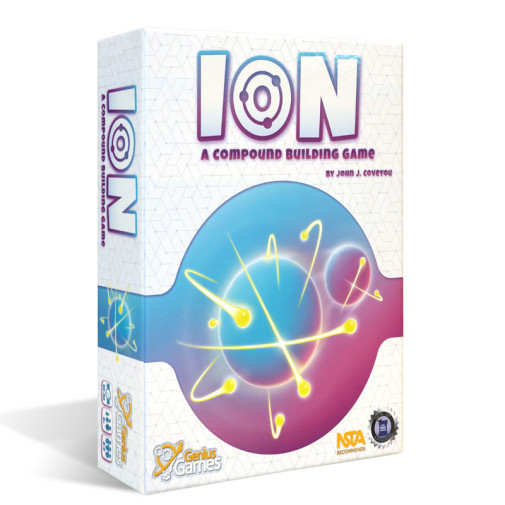We use cookies to make your experience better. To comply with the new e-Privacy directive, we need to ask for your consent to set the cookies. Learn more.
Ion: A Compound Building Game (2nd Edition)
Practice building your own ionic compounds and make sense of chemistry. The goal of the game is to create neutrally charged compounds and sets of Noble gases; the player with the most points wins. The game is for 2 to 7 players and includes 9 Compound Goal Cards, 21 Action Tiles, and 94 Drafting Cards. Each player is given a set of three Action Tiles. Place four drafting cards and two Goal Cards face up in the center of the table, and deal eight drafting cards to each player. Each player chooses one card to reveal and bond to an ion (only cards with opposing charges can bond). Play can be affected by flipping Action Tiles - "select two' allows a player to select and play two drafting cards, "take from center' allows the player to take one of the Drafting Cards from the center, and "RXN' allows the player to rearrange their cards and take a card from another player. Game play is 20 to 30 minutes and expansion cards are included for those who want an even greater challenge. This game can help your chemistry students learn about ions and chemical bonding, or maybe they just love chemistry! ~ Donna
Science Concepts: ionic bonding, elements, atoms, charges, ions, anions, cations, noble gases, halogens, alkali metals, Alkaline earth metals, compound naming, creating neutrally charged compounds, transition metals, polyatomic ions, reactions, acids and bases.
New to 2nd Edition: Entirely new artwork, new theme, and updated rulebook for a faster, more exciting experience with further accessibility to new and old gamers alike.
Ion: A Compound Building Game is a simple card drafting game where players select from a number of available ion cards and noble gas cards, with the objective of forming either neutrally charged compounds or sets of stable noble gases.
Each player is initially dealt eight cards. They choose one card and pass the remaining to the player on their left, while they receive the same amount of cards from the player on their right (this is commonly referred to as "card drafting" or "pick and pass").
Selected cards must be either (1) bonded to another ion or (2) set alone. Players only score points for neutrally balanced cards. So a positive charged Sodium (Na+) bonding with a negatively charge Chloride (Cl-), forming a neutral NaCl compound, would score points.
Points are scored at the end of each round and player may gain additional points for building specific compounds listed on the goal cards for that round. After three rounds the player with the most points wins!
Homeschool Chemistry Curriculum, Workbooks, Lab Materials, Kits, Games, and Chemistry Lab Supplies
| Product Format: | Other |
|---|---|
| Brand: | Genius Games |
| Grades: | 3-AD |
| EAN/UPC: | 653341739308 |
| Length in Inches: | 7 |
| Width in Inches: | 5.25 |
| Height in Inches: | 1.625 |
| Weight in Pounds: | 0.9 |

